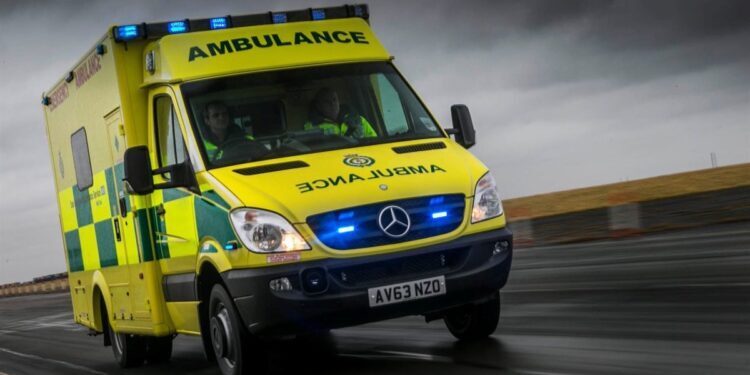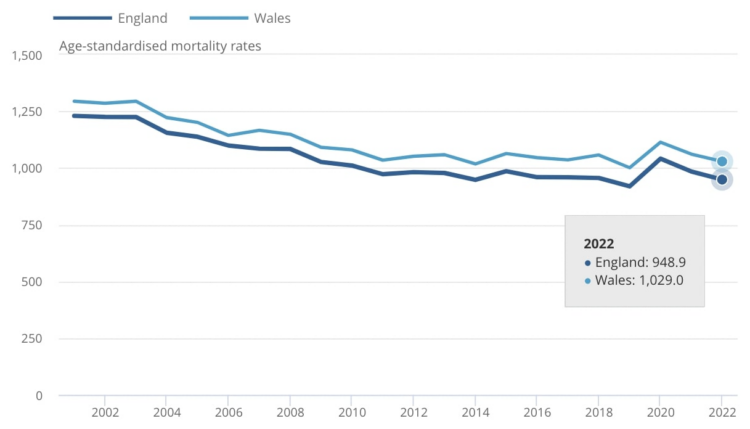The Times article is particularly illustrative. "Excluding the pandemic years, 2022 brought the highest excess deaths total since 1951," it claims. What's more, "Covid accounts only for a minority of recent extra deaths" which means "the crisis in the NHS is killing hundreds of people a week".
None of this is true. Or if it is, it's highly misleading.
The error stems, as I've mentioned numerous times both here and elsewhere, from ignoring age-structure - from using the absolute number of deaths, rather than the age-standardised mortality rate. It's the same error the media has been making all the way through the pandemic.
Like most developed countries, Britain has an ageing population. The percentage of people in older age-groups is increasing. This means the percentage of people at high-risk of dying is increasing. And when the percentage of people at high-risk of dying goes up, the absolute number of deaths rises too.
If we don't adjust for population ageing when estimating the level of mortality, we'll erroneously conclude that the current year was more deadly than previous years. To quote an article I wrote back in January of 2021:
Demographers typically use age-adjusted measures when comparing mortality rates over time or across countries. Simply adjusting for total population is insufficient. For example, Mexico and Japan have approximately the same total population. Although the risk of dying at any age is lower in Japan — as reflected by its higher life expectancy — there are actually fewer deaths each year in Mexico (at least ordinarily) because of its younger population.So what happens if we look at the age-standardised mortality rate? The latest numbers for England and Wales were just published by the ONS:
The population-weighted age-standardised mortality rate in England and Wales was 953 per 100,000. While this was higher than in 2019, it was lower than in 2021, 2020, 2018, 2017, 2016, 2015, 2013 and every year before that. In other words, 2022 was the third least-deadly year ever.
2022 doesn't do quite as well on excess mortality - age-adjusted excess mortality to be specific. But the level recoded was far from unprecedented. Going back to 2006 (which isn't particularly far), it had the fourth-highest excess mortality after 2020, 2021 and 2015.
Remember what the Times claimed? "Excluding the pandemic years, 2022 brought the highest excess deaths total since 1951." We can now write our own version: excluding the pandemic years, 2020 brought the highest age-adjusted excess mortality level since... 2015.
It's also worth noting that even though 2022 had the fourth-highest excess mortality since 2006, it was still negative: last year's age-standardised mortality rate was lower than the five-year average from 2015-2019. Hardly cause for panic.
I don't doubt there are problems in the NHS, but claiming it's in "crisis" because of elevated excess deaths, when 2022 was the third least-deadly year ever, doesn't make a whole lot of sense.
Stop Press: The Kraken isn't all its cracked up to be. According to the ONS, the number of people infected in England and Wales declined by a third if you compare the week ending January 10th with the previous week. MailOnline has more.





Comment: The facts in the above article that the population in the UK is aging is true and that is the trend in many European countries. Excess death rates among these people are not because of their older age, although it can be a factor that increases the number.
But it is also true that most of those people were vaccinated with a number of doses of mRNA vaccines which are dangerous and can cause heart problems and blood clots. Also, many young people, especially athletes died suddenly from cardiovascular problems and blood clots after receiving an mRNA shot.
Assigning all these deaths to the aging population is just an attempt to hide the genocidal agenda being pursued by our psychopathic establishment.
See also: